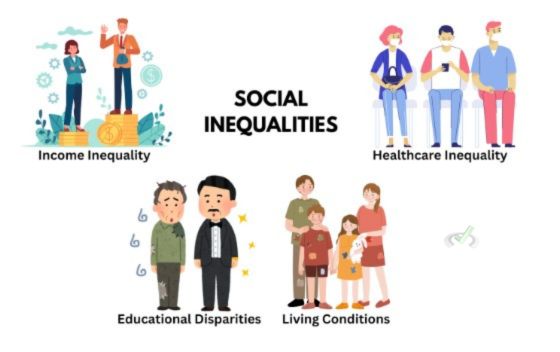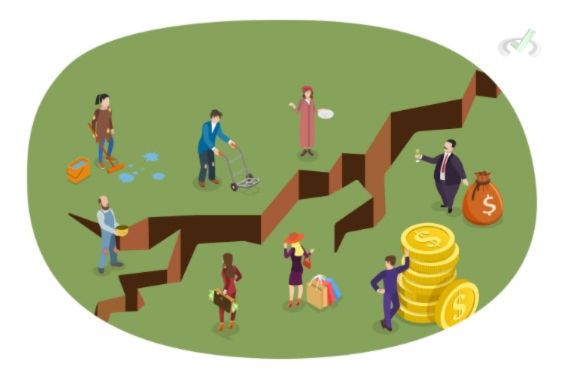Every society has differences among its members, such as income, education, and health. These differences can lead to social inequalities and disparities. Understanding these inequalities is important in sociology because they affect how people live and interact. Let's explore why social inequalities and disparities matter.
II. Introduction to Social Inequalities and Disparities
Social inequalities refer to the unequal distribution of resources, opportunities, and treatment among people. These can include differences in income, education, healthcare, and living conditions. Disparities are the gaps that exist because of these inequalities. Studying these issues helps us understand who has more advantages and who faces more challenges.
III. Components of Social Inequalities

Social inequalities have several vital parts that sociologists study to understand their impact better:
Income Inequality
come inequality refers to the gap between the rich and the poor. Some people have a lot of money, while others have very little. This affects their quality of life and opportunities. For example, wealthier people can afford better education and healthcare.
Educational Disparities
Educational disparities mean that only some have the same access to good schools and learning resources. Some schools have better teachers and more resources, while others lack basic supplies. This can affect a person's future job opportunities and income.
Healthcare Inequality
Healthcare inequality is when some people get better medical care than others. This can be due to a lack of insurance, fewer healthcare facilities, or high costs. It affects people's health and life expectancy. For example, people in poorer areas might not have access to hospitals or doctors.
Living Conditions
Living conditions refer to the quality of housing and neighborhood resources. Some people live in safe, clean environments with parks and good schools. Others might live in overcrowded, unsafe areas with few services. This can impact their health, safety, and overall well-being.
IV. Causes of Social Inequalities
Social inequalities can be caused by various factors, including:
Economic Factors
Economic factors include job availability, wages, and economic policies. For example, jobs that pay well may only be available to those with higher education.
Social Factors
Social factors include discrimination based on race, gender, or age. For example, women and minority groups may face barriers in the workplace, leading to lower income and fewer opportunities.
Political Factors
Political factors involve laws and policies that favor certain groups over others. For example, tax policies might benefit the wealthy more than the poor.
Historical Factors
Historical factors include past events and practices that have created long-term inequalities. For example, slavery and segregation have had lasting effects on the opportunities available to African Americans.
V. Effects of Social Inequalities

Social inequalities have wide-ranging effects on individuals and society:
Health
People with lower income and poor living conditions often have worse health. They may not afford healthy food, safe housing, or medical care. This leads to higher rates of illness and shorter life expectancy.
Education
Educational disparities affect future job opportunities and income. Children from low-income families may need more resources like books and computers to do better in school.
Social Mobility
Social mobility is the ability to move up in social class. Inequalities make it harder for people from low-income families to improve their situation. They may face barriers like high education costs or lack of job opportunities.
Crime
Higher levels of inequality can lead to more crime. People who lack opportunities may turn to illegal activities to meet their needs.
VI. Addressing Social Inequalities

Addressing social inequalities requires actions from individuals, communities, and governments:
Education Programs
Improving schools in poor areas can help reduce educational disparities. Programs like free lunch and after-school activities can support children from low-income families.
Healthcare Access
Policies that provide affordable healthcare for all can reduce healthcare inequality. This includes expanding insurance coverage and building more clinics in underserved areas.
Economic Policies
Raising the minimum wage and providing essential job training programs can help reduce income inequality. Tax policies that support low-income families can also make a difference.
Anti-Discrimination Laws
Enforcing laws that prevent discrimination based on race, gender, and other factors can promote fairness. This can include workplace policies and practices that ensure equal opportunities for all.
VII. Bridge/Overlap
The study of social inequalities and disparities overlaps with other important sociology topics such as social stratification, social mobility, and public health. Let’s explore these connections:
Social Stratification
Social stratification means ranking of people in a society based on wealth, race, and education. Understanding inequalities helps analyze these ranks and their impacts. For example, income inequality shows economic differences that affect social classes.
Social Mobility
Social mobility is the ability to move up or down the social ladder. Addressing inequalities can help improve mobility. For example, better education and job opportunities can help people from low-income families move to higher social classes.
Public Health
Social inequalities directly affect public health. Poor living conditions and lack of proper healthcare access lead to worse health outcomes. Understanding these links helps create policies to improve health for all.
VIII. Wrap-Up and Key Terms
Let’s summarize what we’ve covered about social inequalities and disparities:
- Social inequalities are the unequal distribution of resources and opportunities.
- Key components include income inequality, educational disparities, healthcare inequality, and living conditions.
- Causes include economic, social, political, and historical factors.
- Effects impact health, education, social mobility, and crime.
- Addressing inequalities requires education programs, healthcare access, economic policies, and anti-discrimination laws.
- Inequalities connect with social stratification, social mobility, and public health.
IX. Practice Questions
Sample Practice Question 1
What is one effect of income inequality?
A. Better health for everyone
B. Unequal access to quality education
C. Equal job opportunities
D. Reduced crime rates
Ans. B
Income inequality means some people have more money and can afford better education, while others cannot.
Sample Practice Question 2
How can healthcare inequality be reduced?
A. By building more hospitals in wealthy areas
B. By making healthcare more affordable for everyone
C. By providing only emergency services
D. By ignoring healthcare needs
Ans. B
Affordable healthcare ensures everyone can access the necessary medical services, reducing inequality.







 To help you achieve your goal MCAT score, we take turns hosting these
To help you achieve your goal MCAT score, we take turns hosting these 





















 reviews on TrustPilot
reviews on TrustPilot